Not Straightforward or Impossible: sgp in Conversation with Alina Yakirevitch

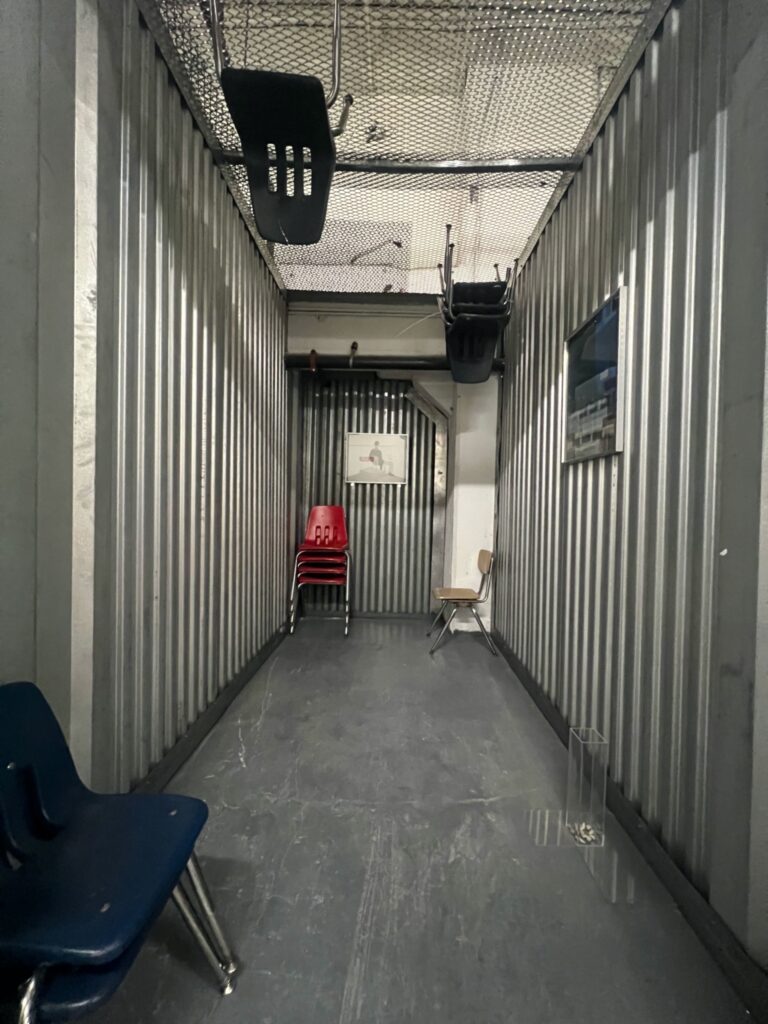
Grounded in refusal of categorization, sgp is an anti-disciplinary artist. She uses found materials and information in order to question viewers’ relationships to the invisible mechanisms that govern the art world and underlie capitalism. A recent graduate of Hunter College, sgp considered her pursuit of an MFA as a performance in professionalization and has centered ‘found’ chairs in her most recent series. In her thesis project, “RED HOT SHAME,” sgp employed conversation, rumor, contracts, and other print media in an attempt to sell student debt as an art object. that straightforward impossibility (iii) is her first solo show and continues to ground and enliven debt in sculptural objects and texts. This performative installation at Manhattan Mini Storage is open to the public by appointment through April 30. As a final gesture, the artist will default on payment for the storage unit, letting a version of the installation go to public repossession auction at storagetreasures.com on June 10. The last hour of the auction will be screened live. Since 2010, sgp has written, performed, and shown work under many noms de plume including Sara Grace Powell, Kelsea Wollffllotterr, and Lee G. Rawls. She was a Social Practice Actionist at CUNY and her work has appeared in Riot of Perfume, SOMA, MoMA PS1, Bortolami, Hauser & Wirth, and Æther Arts Space, to name a few.
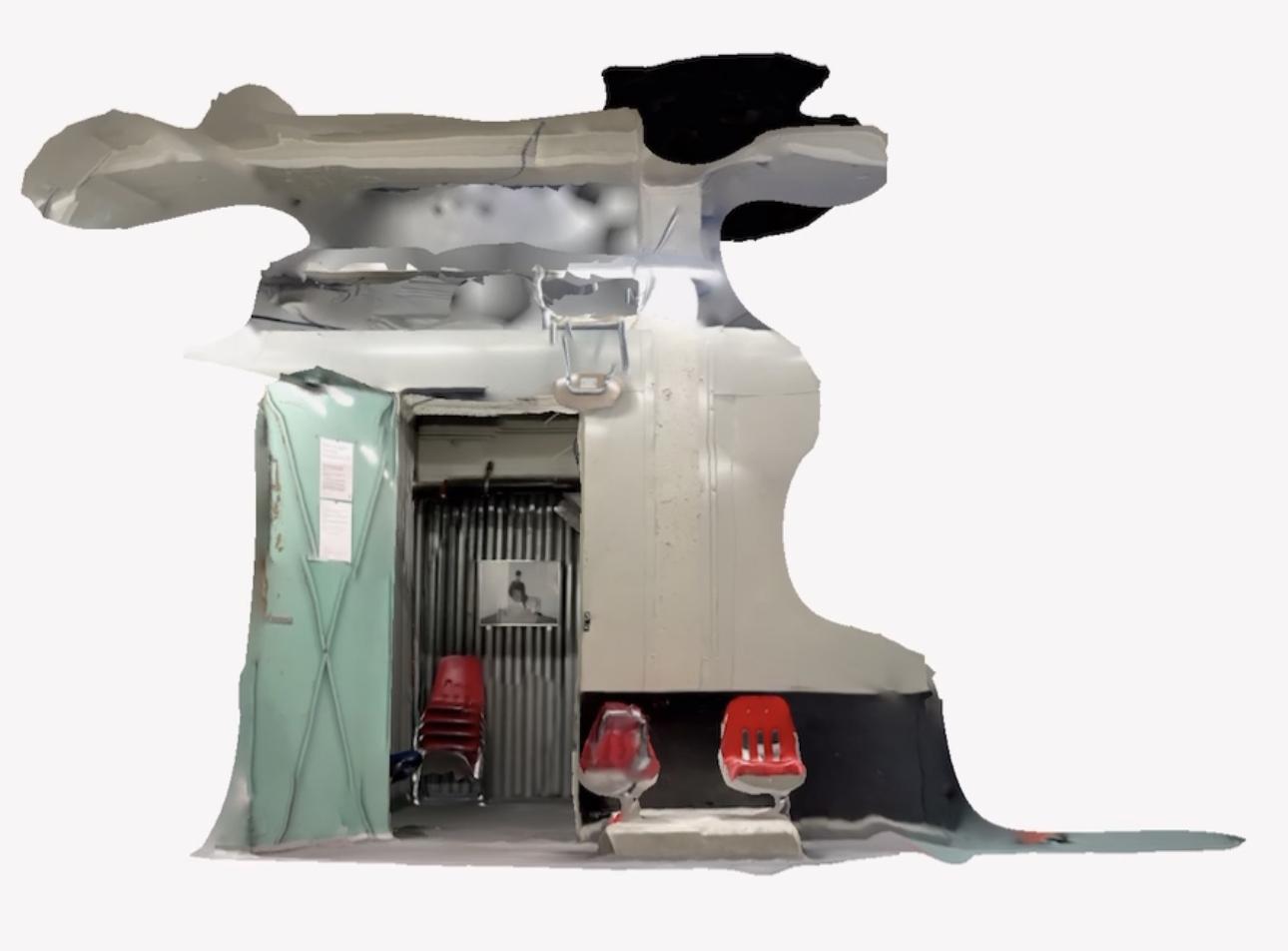
Alina Yakirevitch: Your latest installation, that straightforward impossibility (iii) is the most recent embodiment of your investment in debt, storage, auction. You locate us in a storage facility, with a specific entrance score, where viewers are complicit in an unknown action by entering a specific key code in order to access the show and find you somewhere in the basement of the facility. Once we finally found each other at the intended storage unit, you offered me chewing gum. The unit contains two time-based prints, a small acrylic sculpture that acts as a guestbook where viewers are meant to deposit their chewing gum once they leave, a modular Virco chair sculpture, a press release, and a checklist. There is also quite a large piece installed outside of the unit, the “Loveseat.” How did you become interested in economic systems, on which you seem to be an expert of sorts?
sgp: While I do not feel like an expert, I am someone who fortunately or unfortunately has proximity to hoarders and hoarding, proximity to medical and student debt, proximity to repossession auctions, bankruptcy, and loss. I, like many others, have had to navigate all these realms and see my playfully antagonistic engagement with debt and financial systems occupational therapy of sorts. Aside from how everything is tethered to my own biography, these physical and financial infrastructures are very real, yet often made invisible. In capitalist society accumulation is the goal; people aspire to hoard wealth or art. However, within these accumulative aspirations hoarding useless objects is quickly pathologized. Yes, the direction of harm is different (often with hoarding “useless” objects one is at risk of harming oneself, whereas with “valuable” objects harm is more often inflicted upon others). What I am trying to get at, with this installation specifically, is how both sides of this accumulation are similar—obviously value systems under capitalism rank hoarding wealth and hoarding useless objects differently—but each form of accumulation is an obsession with the past, or an obsession the future; both some sort of reaction to mortality or some sort of prophylactic against death. Two texts that catalyzed this work were David Graeber’s Book “Debt: The First 5,000 Years” and the “The Undercommons” by Fred Moten and Stefano Harney, specifically their chapter on debt. These thoughts about accumulation led me to draw parallels between how debt collections agencies buy debt and how repossession auctions (of storage units) function. Both exist in speculative markets, both are a strange sort of wholesale, both events occur after some sort of default, and in both the purchaser only gets a small sliver of information about what they are purchasing.
AY: I am curious about how exactly the show came together. How did you choose the unit? While the show is open you are maintaining a practice of having appointments with viewers and having to pull out a large loveseat made of concrete and found chairs for the day, then pulling it back when leaving. I would even argue that this kind of presence of the artist in their show is quite unusual nowadays New York.
sgp: It grounds the work in my history with performance. I was working out of the storage facility as a studio, just as a pretty cheap space but also an extension of everything I was working on in my thesis project, “T.R.A.S.H. (Trans Relational Affective Stuff Hoard/Horde).” When I moved my studio there in July, I knew I wanted to do a show in a unit and allow that space to go into default, ending up, eventually, at a public repossession auction. It became clear that that unit, of the three I was renting, was where the show was going to be—because of the architecture, because of the light that only comes through the door bisecting the whole installation, the makeshift ceiling constructed with a metal grid, and this condom wrapper visible through that wire mesh of a ceiling. And, I did not want people to just find it on their own because so much of the work was about exchange and about conversation and really getting into how these things touch all of our lives. Most people have a relationship to debt and storage units—even those who have vowed to never have them, which is a relationship as well. So, your visit is totally opposite to how didactic the press release and the instructions to enter the unit are. You have this whole protocol, and then you come in and it is actually a pretty warm exchange between people, it becomes pretty intimate. I am certainly invested in inviting intimacy back into these spaces. I am interested in how the facility’s rules work in these spaces because there are so many rules—to prevent people from living there, for example. Moving the Loveseat in and out is just me following the rules, and not making any permanent changes to the unit, making sure no damage is done. It is one of the rules that I am following under my own rubric of my practice.
AY: In all this intimacy and particularity, you are still working within a system that can and will put the installation in default if you fail to pay. What does this process of repossession represent for you?
sgp: Yes, I am letting the system play out the most disastrous version of itself, a “straightforward impossibility”—it is straightforward because it allows the storage auction system to function exactly as it is meant to. An impossibility because who would actively want to put themselves in this position? But I have this working theory that there are two main reasons to why people go into default. One is the tragic narrative, —that I have experienced—where the renter cannot afford to pay for the unit so it goes into default, the loss is then beyond their control. The other is a flip side, people who do not want their stuff back. Since they have lived without their stuff for X amount of time, they decide to just let it go. When you default, for whatever reasons, and storage contents go to auction none of the money from the auction will go to the renter-turned-debtor. In my mind this process is directly linked to how debt is bought and sold. Debt is bought blind and wholesale; collection agencies usually do not really know what they are getting, they are just speculating that they will be able to use the shame and isolation foundational to debt, like the weird moralism around it, in order to get debtors to pay. There is a punitive history around debt that many thinkers have laid out, the word “forgiveness,” for instance, implies that debtors have done something wrong.
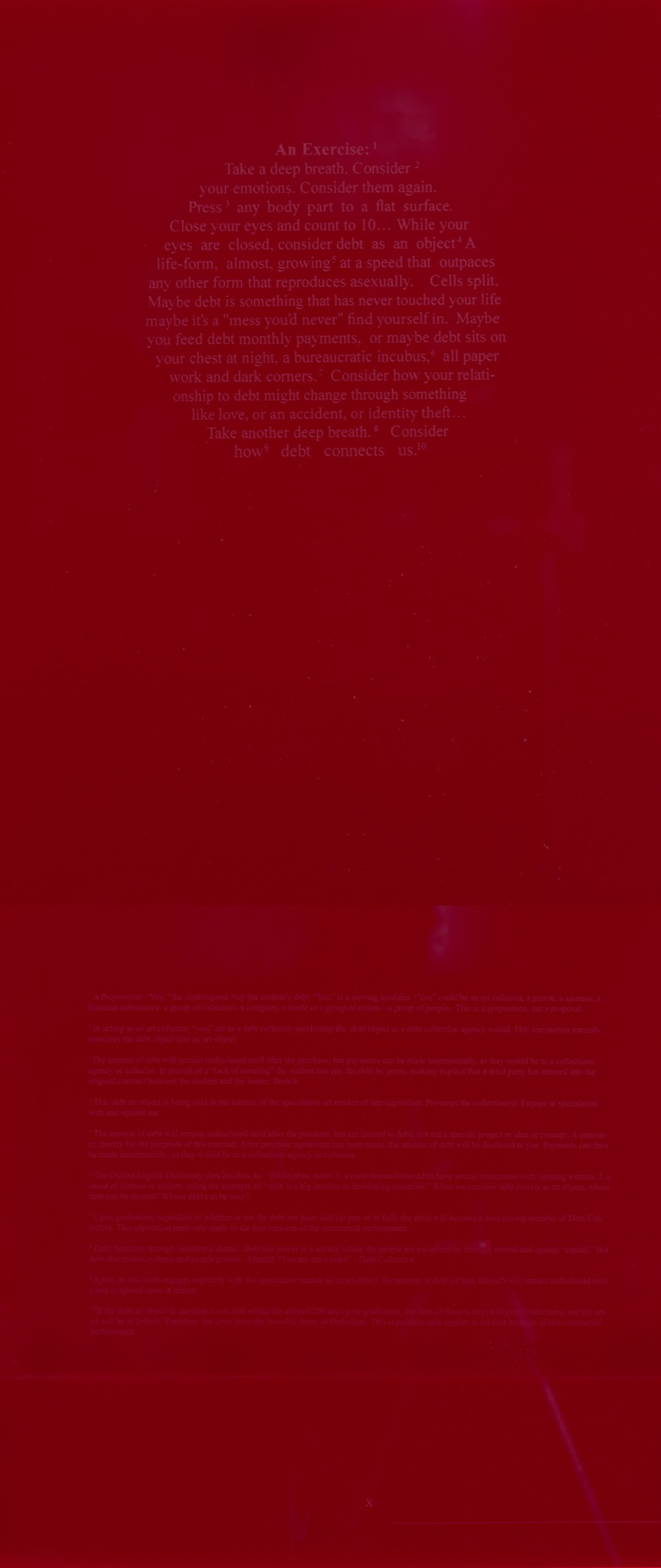
AY: I want to talk about the use of text in your work and the way writing is an integral part not only of your practice but of your installations. Alongside the physical work in the space, the checklist and the press release are pieces in their own right.
sgp: Yes, language is a big part of my work: writing, conversation, rumor, especially for “RED HOT SHAME.” They are all part of this irreconcilable form I am always chasing. I am invested in the refusal of categorization, cannot self-classify as an Institutional Critique artist, nor a Performance Artist, nor a Conceptual Artist, nor a Social Practice artist—all of these historicized or historicizing classifications feel pretty unsatisfactory. For me, art ideally remains somewhere beyond language, even if it employs language. But, if and when I have to use words, which artists are consistently asked to do, to self-categorize, I use “anti-disciplinary.” Or “infrastructural critique”—a term a friend is developing—where you deal with all of this economic, human, or industry infrastructure that are not particular to arts institutions. Yet these unseen mechanisms or infrastructures (i.e. the storage industry) are both totally involved and erased from view to make everything look and function the way it looks and functions—I am there, stuck in that web. Which is also why I was adamant about having my first solo show in this space that is one more found thing in the ecology of materials that I work with. I used to do a lot of public interventions and performances that were subtle and usually had no announcement. I was very inspired by the way Adrian Piper engaged with the public in some of her earlier works, specifically “Catalysis IV” (1971) where she was on the bus or in public space performing these subtly absurd actions: sitting on the bus gazing into the distance with cloth stuffing into her mouth, riding another bus in clothing soaked in materials that produced noxious fumes, walking around downtown wearing a sign gesturing to the fact that this very action is art, or even the performance for Max’s Kansas City (done specifically for an art audience or “art consciousness”) where she literally desensitized herself using a blindfold, ear plugs, thick rubber gloves. Even though she was made visible via these sorts of absurd actions, they remained subtle even while loud (or smelly). Documentation has acted as evidence and created myth of the work. In the case of “that straightforward impossibility (iii)” the press release and the viewers’ documentation via cell phone photo are an extension of the work.
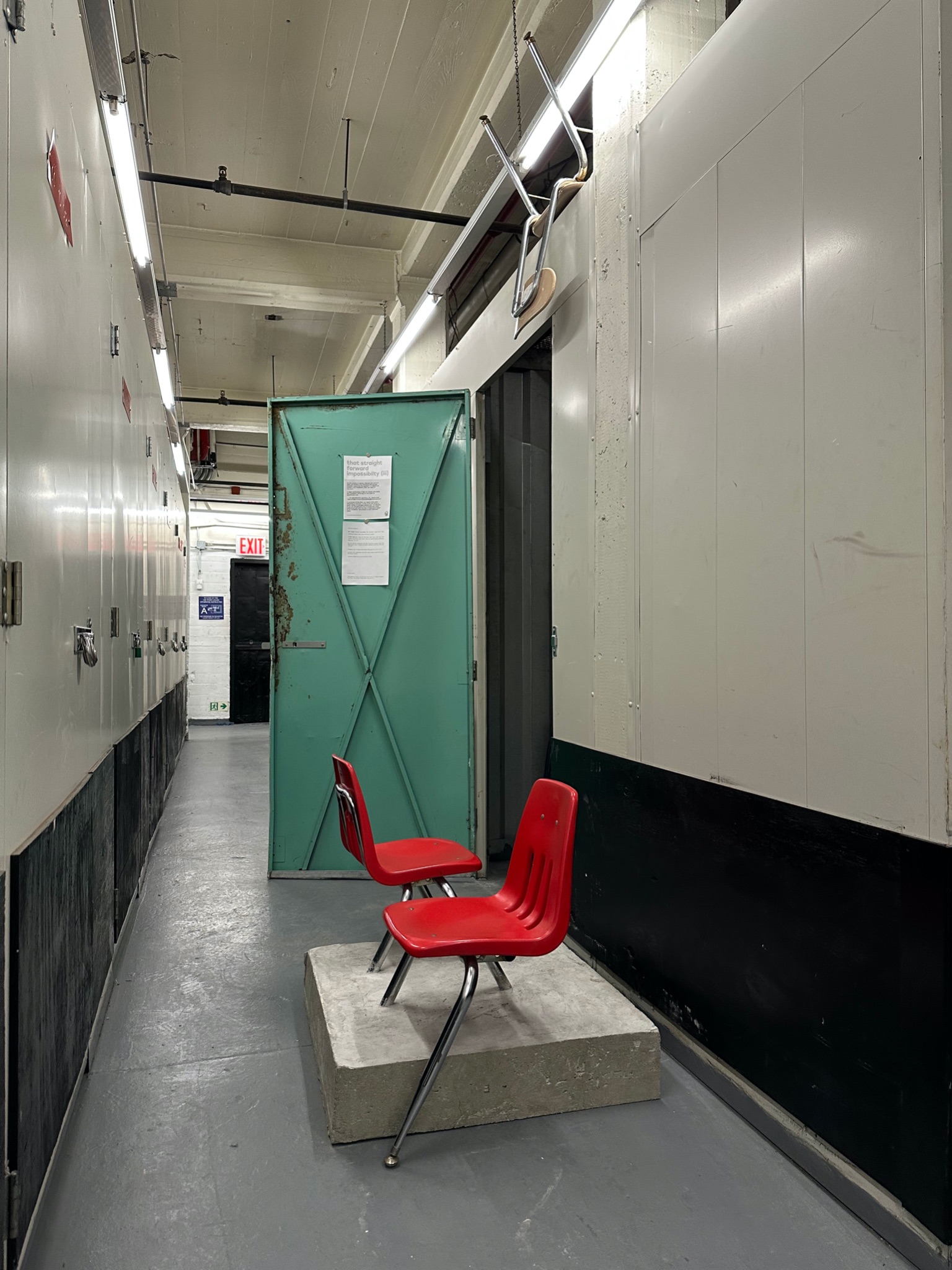
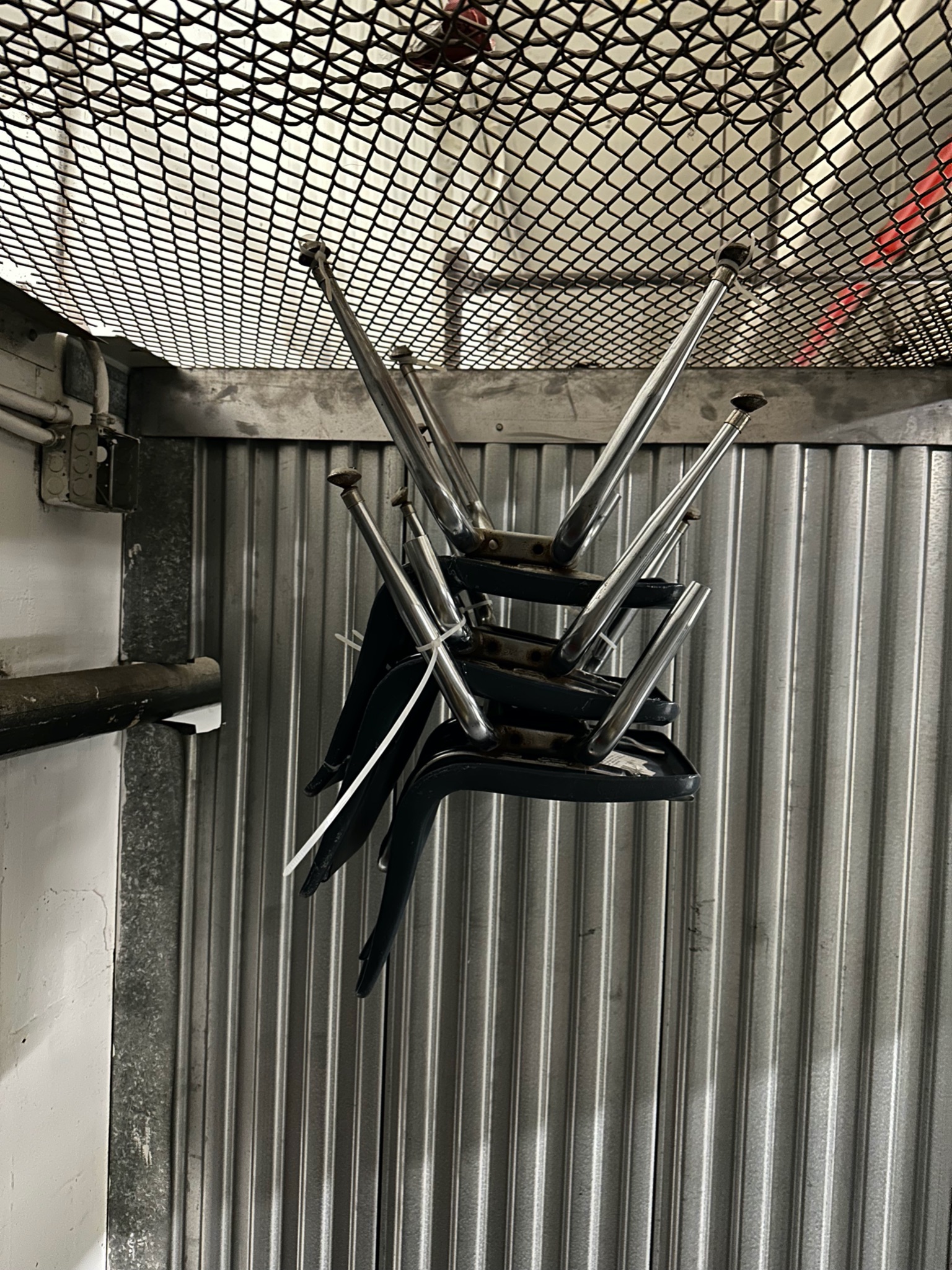
AY: Can we talk about the chairs you have been collecting and using in all these different ways in your installations for several years now? I saw about forty of them installed in a grid on the floor in Hauser & Wirth. In your thesis show at Hunter, some were hung upside down from the ventilation systems, while another was situated in the center of the space, prevented from falling by a pole that extended about 17 feet upward, all the way to the ceiling. The chairs appear in different sizes and colors; sometimes they almost seem functional when standing on the floor, at other times their legs are against the wall like in some kind of whimsical joke on gravity.
sgp: I am pretty particular in saying that I hoard Virco(TM) chairs. I do not collect them. I started hoarding them in response to taking out debt to attend Hunter but I think I will work with them for years to come. There is something about this legal term that is tied to them in my mind, called “lack of standing” which is an argument debtors can make if they come to court in person. Legal poetry. As debt is bought in bulk, you can come and say to the debt collector: “ok prove that it is my debt and prove that I had a contract with you.” Usually, they cannot. Often when the collection agency comes in, they are a third party, therefore breaching the contract between the original two parties. So, “lack of standing” was just this perverse legal jargon I got fixated on after I started hoarding these chairs that are most often found in schools or religious institutions. Adding an additional layer, they are made by an industrial manufacturer that uses prison labor. At first, I built them to fall down since they were included in institutional shows, like Hunter or Hauser & Wirth. Then I started adding invisible mechanisms to support them, like magnets, which parallel the false moralism around debt. Like, how can a three-legged chair continue to stand, to defy gravity?
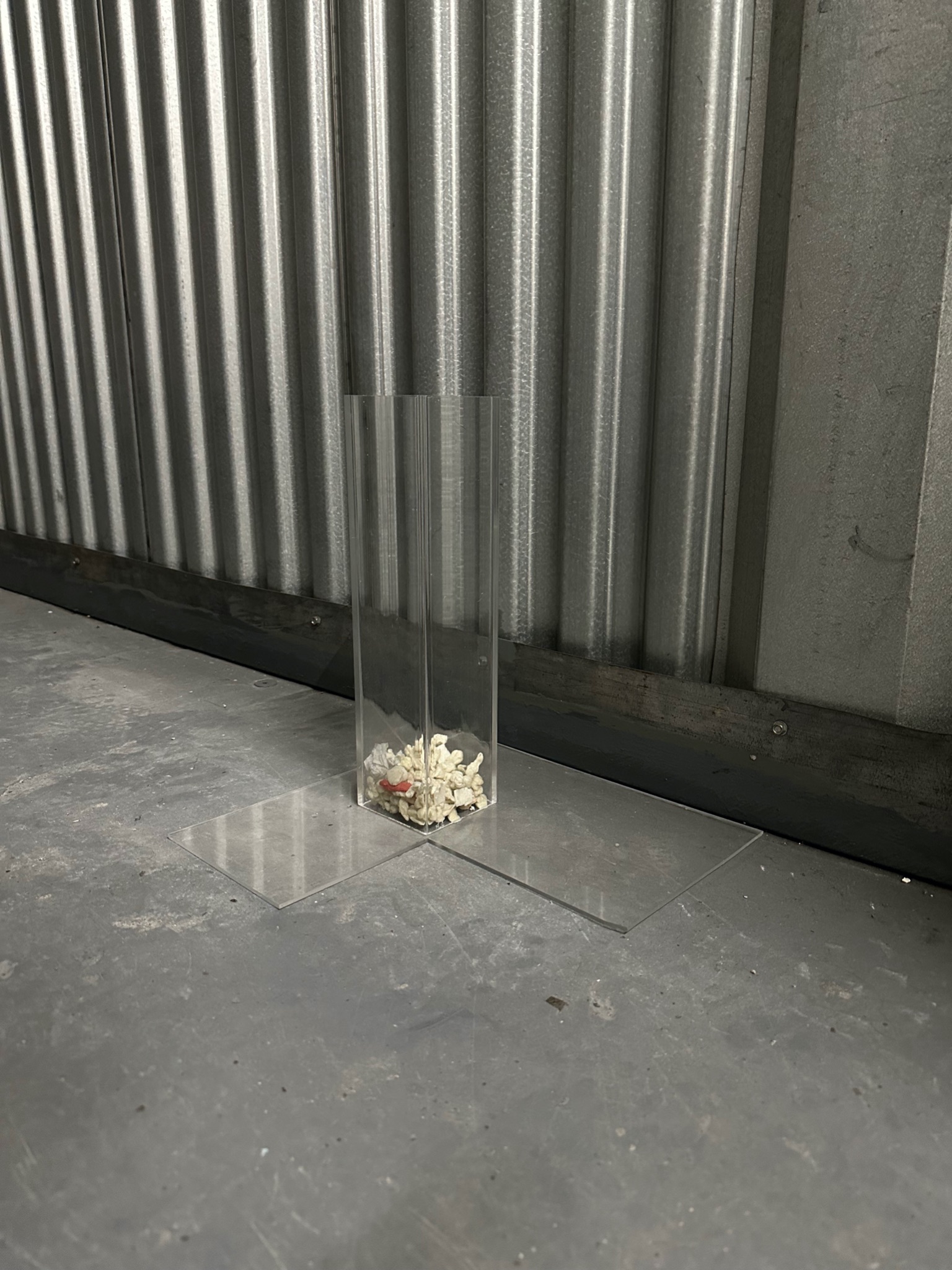
AY: Speaking to the sculptural values of your work, I find that you are often playful with space. You hang things from the ceiling and there are all these elements of chance or luck. To me, there is always something lucky happening in your work and you said part of it also is just the ability to see what comes up. So, I am curious to talk about the visual nature of the work which I find so rich and rewarding, regardless of the conceptual content.
sgp: Thank you. I mean, that is the idea right? It’s not supposed to be this hermetically sealed conceptual thing, rather it is supposed to work across multiple vectors. Especially because there is entropy, there is chance. But I do really think that once you put a work out in the world, you lose control of it in a way.
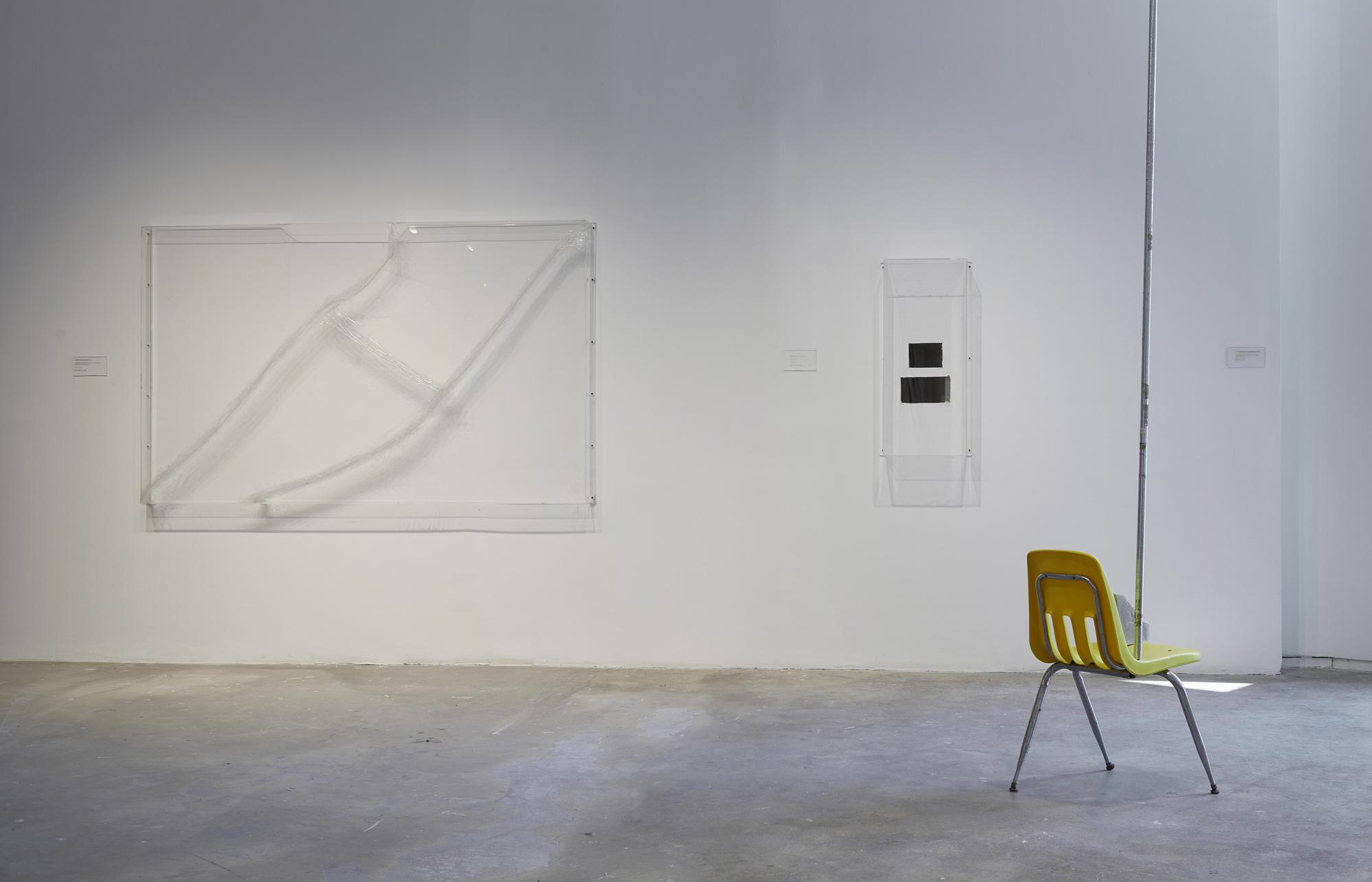
AY: This acceptance of the loss of control coupled with grounding the concepts of debt and storage in physical objects feels like one of the things that differentiate your work from that which is categorized as Institutional Critique. Specifically, the aesthetic choices you make feel quite generous and the work functions even if the viewer cannot immediately grasp its conceptual agenda. Your work, and this installation particularly, does not seem to require a specific art historical education in order to “be in on the joke.”
sgp: Yes, there is sculptural logic. You could even frame debt as a hyper object, so these chairs are merely one access point. Once I start thinking about a piece it usually takes a while for it to come together because everything I use is found. Thus far, I have refused to have something fabricated; I need to find the zip ties, I need to find the rebar that supports the concrete, I need to find every physical component of the work. How can I disassemble and reassemble materials and infrastructures in order to catalyze something new? Sometimes it does feel fortuitous but sometimes I am also just leaning into the powerlessness of trying to create without participating in the consumption and destruction the art world is complicit in, so I end up making aesthetic compromises. But, most of the time compromise leads to something even better.
AY: Considering debt is a central material, what was it like to finance this exhibition?
sgp: Each piece in the unit is for sale for one dollar less than the monthly rent of the storage unit. I was not planning on extending the show until somebody came about a week or two before the initial default and paid for two months of rent to keep the show open. It felt conceptually relevant to me, and was definitely something I had previously thought about, especially with selling debt as an art object. And, another person just paid the rent, for April, too. So, the show will continue to be open by appointment for another month. Something about this is “impossibly straightforward”, too–instead of someone buying a piece in order for me to pay rent, they just pay rent. It seemed like visitors just followed the conceptual bread crumb trail to its end.
that straightforward impossibility (iii) is on view by appointment through April 30th, at least. To see the exhibition follow the instructions in the score below.
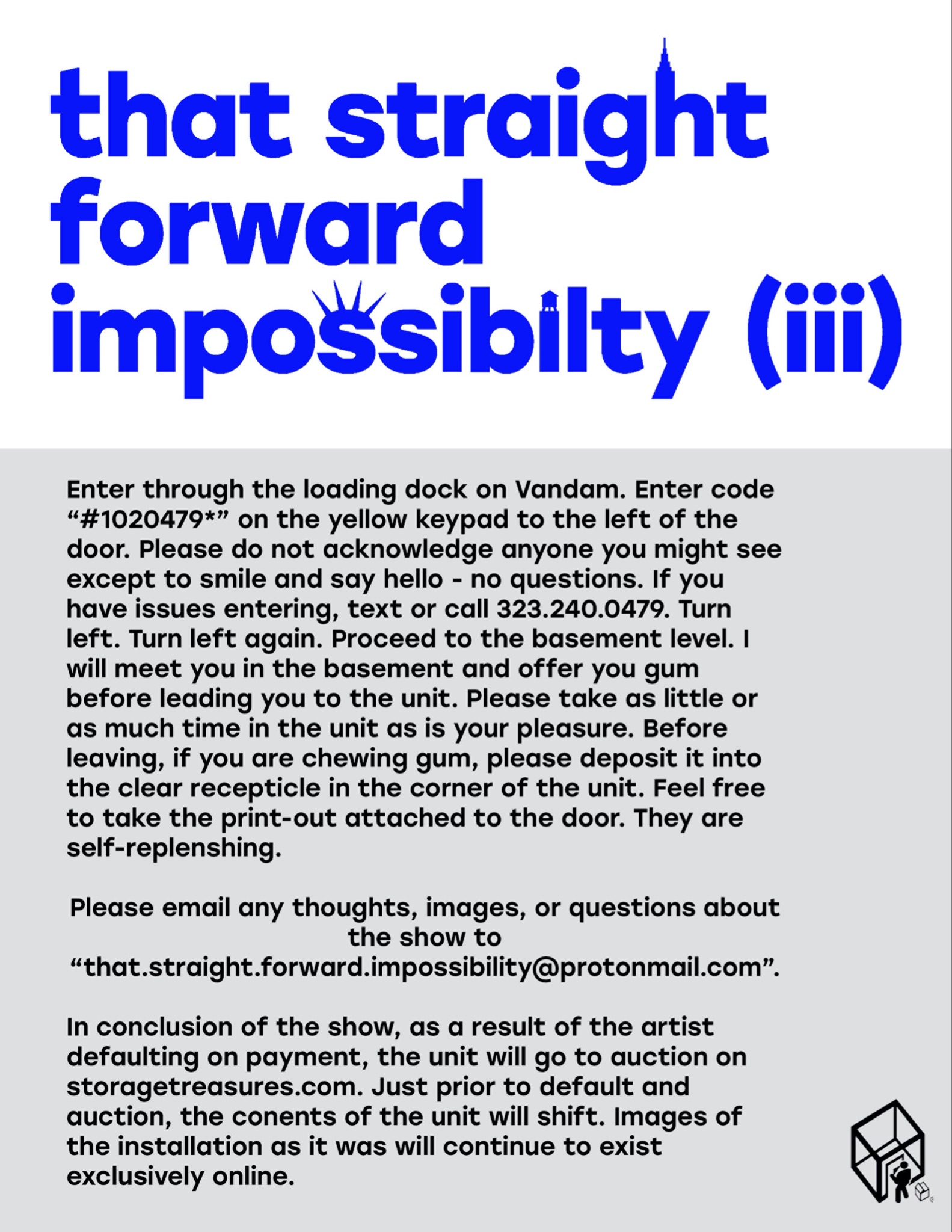
You Might Also Like
State of Becoming: Katya Grokhovsky in Conversation with Leeza Meksin at Ortega y Gasset Projects
What's Your Reaction?
Alina Yakirevitch is a multidisciplinary artist and writer based in New York. She was born in Russia in the mid-'90s, amidst the transition from failed Communism to radical Capitalism. Awareness of these political systems, the tension between them and the structures of life they dictate, is a core matter in her artistic practice. Her works have been shown at Hauser and Wirth Gallery, New York, Trestle Gallery, New York, and Tel Aviv Museum of Art, among others. She holds an MFA from Hunter College and also works in education and film production. l Instagram l Website l

